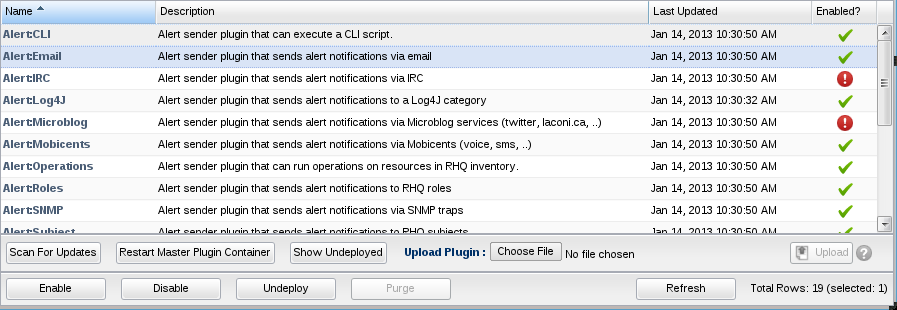This page discussed server plugins. If you are interested in updating agent plugins, please see Agent Plugin Administration.
Adding or Updating Server Plugins
There are times when you want to install a new server plugin or update an existing server plugin to your RHQ environment. This page explains the steps needed to perform this task.
-
Log into the RHQ GUI as a user with the proper permissions to edit the server settings
-
Go to the Administration>Configuration>Plugins page

-
Upload the new or updated plugin jar file
-
If you do not want to use the GUI to upload the jar file, you can explicitly copy your plugin .jar file to the plugins dropbox directory located at <server-install-dir>/plugins.
-
If you see problems hot deploying plugins into the server, you can shut down the server and copy the plugin jars to the dropbox directory, then restart the server.
-
If you have more than one RHQ Server in your RHQ Server Cloud, you only need to deploy the plugins to one of the servers; the other servers will automatically detect and copy the plugins.
-
-
At this point, you can wait for the server to auto-detect your new plugin jar file, or you can force it to detect it immediately by pressing the "Scan For Updates" button. The server will log messages in its log file when the plugin has effectively been detected and deployed properly.
Disabling or Enabling Server Plugins
Once the RHQ Server has detected and deployed the plugin jars, you can enable or disable them.
Enabling a plugin will "turn on" that plugin, effectively starting it in the master plugin container running in the server. Within a relatively short amount of time (defined in rhq-server.properties under the setting "rhq.server.plugin-scan-period-ms"), all RHQ Servers in the RHQ Server Cloud will also enable that plugin in their own master plugin containers.
Disabling a plugin will "turn off" that plugin, effectively stopping it in the master plugin container running in the server. Within a relatively short amount of time (defined in rhq-server.properties under the setting "rhq.server.plugin-scan-period-ms"), all RHQ Servers in the RHQ Server Cloud will also disable that plugin in their own master plugin containers.
Undeploying, Redeploying, or Purging Server Plugins
If you never want to run a plugin again, you can completely undeploy it using the "Undeploy" button. This will remove the plugin jar and unload it from the RHQ Server's master plugin container. And within a relatively short timeframe, all RHQ Servers will undeploy that plugin.
If you realize later that you want to re-deploy an undeployed plugin, you need to follow these steps:
-
In the Server Plugin page, click the "Show Undeployed" button to see those plugins that have been undeployed previously.
-
Select the undeployed plugin that you want to "resurrect" and click the "Purge" button. This will erase all memory of that plugin from the RHQ Server.
-
Once the old plugin is purged, you can then re-deploy its new, replacement plugin.
Master Plugin Container
Each RHQ Server has running within it something called the "Master Plugin Container". This is the main object responsible for loading, unloading, starting and stopping server plugins. The master plugin container actually manages all the individual plugin containers which themselves are responsible for managing all plugins of the different types.
You will see in the Server Plugin page the button labeled "Restart Master Plugin Container". Unlike all the other features on this page which affect the entire cloud of RHQ Servers (e.g. if you deploy a plugin, it gets deployed on all RHQ Servers; if you enable a plugin, it is enabled on all RHQ Servers), this button only restarts the master plugin container running in the server that is serving this web page. This is useful mainly for developers that want to force the developer's RHQ Server to restart the master plugin container as part of testing server plugins that are being hot-deployed.